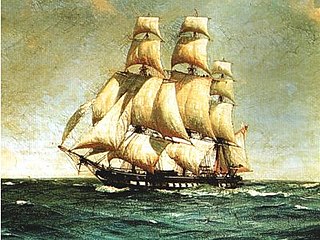
HMS Guadeloupe, was a 28-gun sixth-rate Coventry-class frigate of the Royal Navy. The ship was designed by Sir Thomas Slade, and was initially contracted to be built with the Pembrokeshire shipwright John Williams of Neyland; however he became bankrupt and the Admiralty transferred the order to the Plymouth Naval Dockyard.
Five ships of the Royal Navy have been named HMS Eclair:
Mutine was an 18-gun Belliqueuse-class gun-brig of the French Navy, built to a design by Pierre-Alexandre-Laurent Forfait, and launched in 1794 at Honfleur. She took part in the Battle of Santa Cruz de Tenerife, where the British captured her. She was recommissioned in the Royal Navy as HMS Mutine, and eventually sold in 1803.
Sixteen ships of the Royal Navy have borne the name HMS Alert, while another was planned:

Cybèle was a Nymphe-class 40-gun frigate of the French Navy.
HMS Marie Antoinette was a 10-gun two-masted sloop. She was built in France and was originally called Marie Antoinette. During the French Revolution, she was rerequisitoned and renamed Convention Nationale. A British squadron under Commodore Ford captured her in 1793. The Royal Navy took her into service under her original name, Marie Antoinette. She took part in operations around Saint-Domingue until her crew mutinied in 1797 and carried her into a French port. Her subsequent fate is unknown.

Alceste was a Magicienne class frigate of the French Navy, launched in 1780, that the British seized at the Siege of Toulon. They transferred her to the Kingdom of Sardinia, but the French recaptured her a year later in the action of 8 June 1794. The British captured her again at the action of 18 June 1799 and took her into service as HMS Alceste. In 1801 she became a floating battery and she was sold the next year.
HMS Saint Lucia was a brig-sloop, the former French Navy schooner Enfant Prodigue, which the British captured in 1803 and took into service with the Royal Navy. Under the British flag she captured three small French privateers and several prizes in the Leeward Islands before two French privateers recaptured her in 1807.
The French brig Alerte was launched in April 1787. The Royal Navy captured her at Toulon in August 1793, and renamed her HMS Vigilante. The British set her on fire when they evacuated Toulon in December of that year. After the French rebuilt her as Alerte, she served at the Battle of Aboukir Bay. The British recaptured her in June 1799 and took her into service as HMS Minorca. Minorca was sold in 1802.
HMS Moucheron was a French privateer, built in 1799, that the British captured in 1801. The British government purchased her in 1802 for the Royal Navy. She foundered in 1807 in the Mediterranean without leaving a trace.
Pandour was a French a 14-gun gun-brig launched in 1780 as a cutter. The Royal Navy captured her in December 1795 and took her into service as Pandora, but she foundered in June 1797.
Poulette was a French Coquette-class corvette built to a design by Joseph-Marie-Blaise Coulomb and launched in March 1781. She served the French navy until 1793 when the British captured her at Toulon in 1793. She served briefly in the Royal Navy, including at the battle of Genoa in 1795, until she was burned in October 1796 to prevent her falling into French hands.
The action of 31 May 1796 was a small action during the French Revolutionary Wars in which a Royal Navy squadron under the command of Commodore Horatio Nelson, in the 64-gun third-rate ship of the line HMS Agamemnon, captured a seven-vessel French convoy that was sailing along the coast from Menton to Vado in the Mediterranean. The British succeeded in capturing the entire convoy, with minimal casualties to themselves.
The French brig Duc de Chartres was built between 1779 and 1780 at Saint-Malo as a privateer. The French Navy purchased her in September 1782 at Île de France (Mauritius).
Belliquese was a French Navy 12-gun brig launched in 1793 as the name-vessel of her class, and sold in 1797 to serve as a privateer. The British Royal Navy captured her in 1798. Though the Royal Navy named her HMS Bellete and took her measurements, it never actually commissioned her; she was sold in 1801.
HMS Amethyst was launched in 1790 as the French frigate Perle. The British Royal Navy took possession of her at Toulon in 1793. She was wrecked in 1795 at Alderney.

HMS Eclipse was a French Navy Vésuve-class brick-canonnier or chaloupe-canonnière, (gunbrig) launched at Saint-Malo in 1793 as Volage. She was renamed Venteux in 1795 (possibly also Vérité on 30 May 1795, although this might have been a second ship of the same name. The British Royal Navy captured her in 1803 and took her into service as HMS Eagle, but then renamed her HMS Eclipse in 1804. She had a completely unremarkable career before the Navy sold her in 1807.
HMS Athenienne was a brig, probably a French privateer that the French Navy requisitioned circa April 1796, but that the British captured off Barbados and commissioned later that year before selling her in 1802.
HMS Saint Pierre was launched in 1803 at Bordeaux as Saint Pierre, intended for use as a slave ship. The Department of Eure purchased her and donated her to the French government, which, however, found her unsuitable and returned her to her owner. The French Navy later requisitioned her between July and September 1805 as a storeship and renamed her Diligente. She was at Martinique in February 1809 when the British Royal Navy captured the island. The Royal Navy took her into service as HMS Saint Pierre.
The French Navy's Telegraph-class schooner Vigie was launched at Nantes in July 1799 by Mathurin, Louis, and Antoine Crucy, building to plans by Pierre Ozanne. She was wrecked in December 1810.



